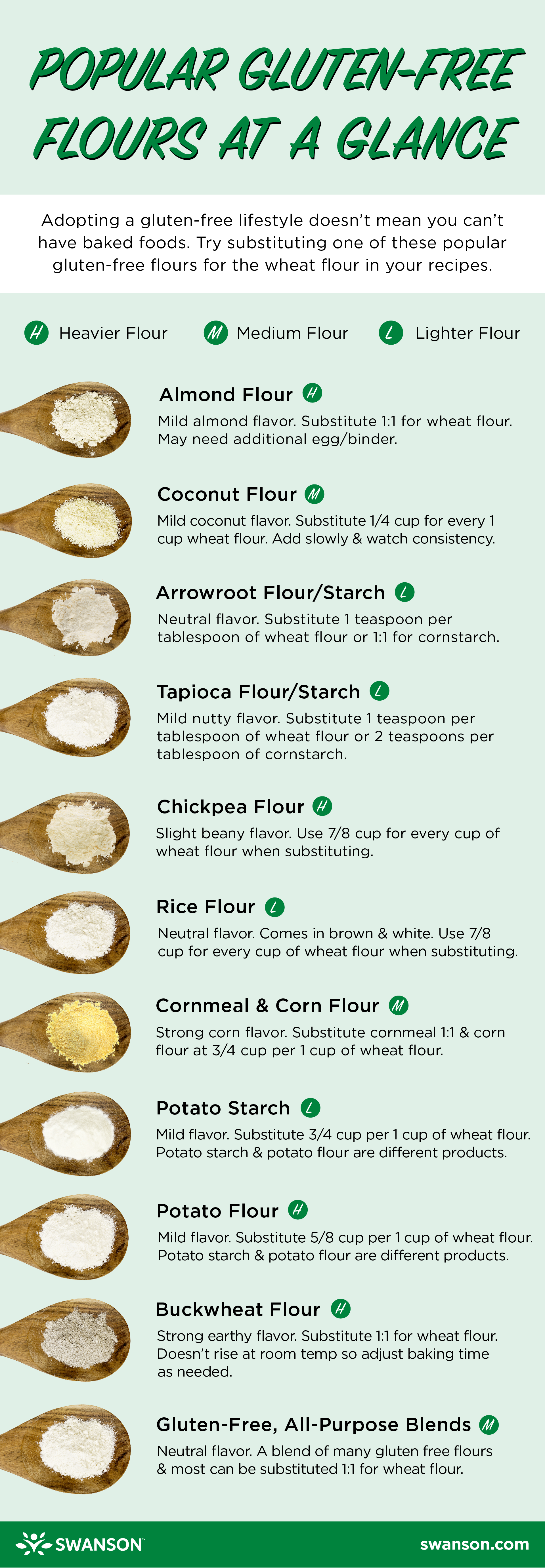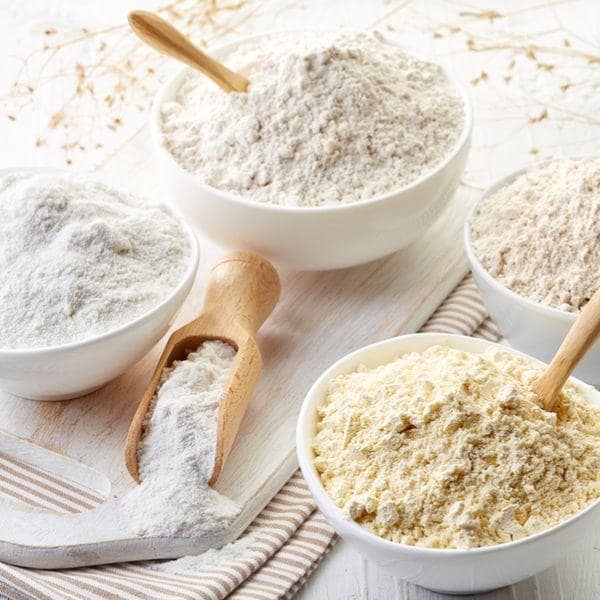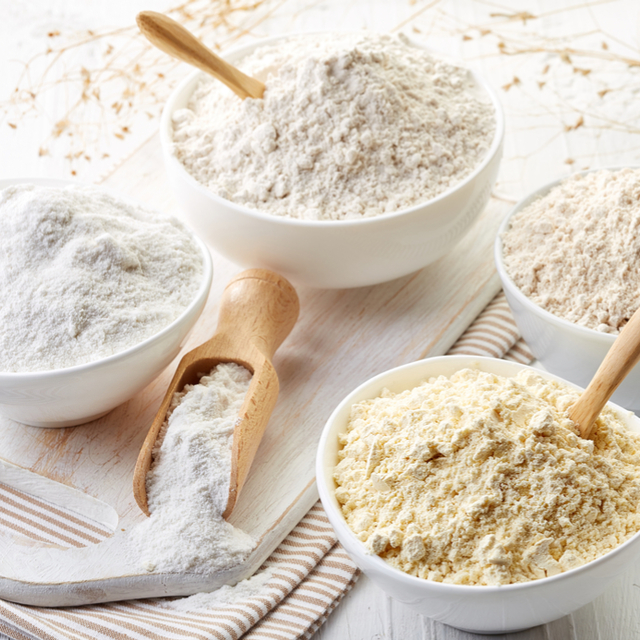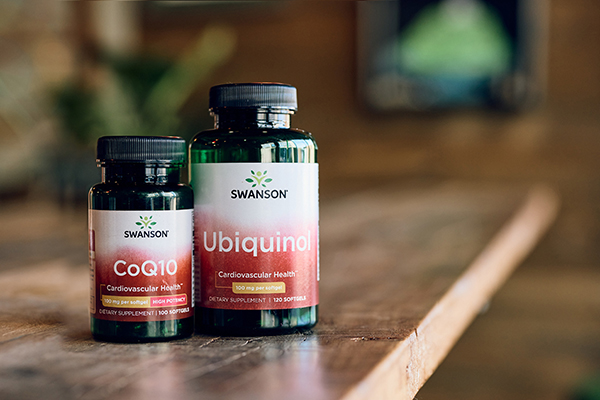Adopting a gluten-free lifestyle doesn’t mean missing out on your favorite baked goods. It’s easier than ever to find gluten-free recipes for everything from bread and muffins to cookies and pizza dough. For many recipes, it’s as simple as just switching to a gluten-free flour!
Use this gluten-free flour guide to learn more about some of the most popular, gluten-free alternatives to wheat-based flour. We’ve also included a few gluten-free recipes to try with each flour, along with general substitution ratios for each. But you should read your product label for substitution instructions as well, because some brands may be different. Also, every recipe is unique, so experiment to find the perfect ratio of gluten-free flour for your favorite recipes.

Almond Flour
Almonds are a source of healthy fats. They are also relatively high in protein and low in carbohydrates. The mild, nutty flavor of almond flour makes it an excellent option for cakes and cookies.
Almond flour is made by grinding almonds down to a fine consistency. You can make almond flour at home by pulsing almonds in a food processor. Pulsing is key because if you blend too much or too fast, you’ll end up with almond butter instead.
Almond flour can usually be substituted 1:1 for wheat flour, though some recipes may require a little more egg or binder to hold it together and you may want to reduce the liquid slightly. Using almond flour often results in slightly denser baked goods.
Almond Flour to Try
NOW Foods Raw Almond Flour
A raw, gluten-free, low-carb flour substitute and a natural source of healthy fatty acids.
Bob's Red Mill Super-Fine Almond Flour
This gluten-free almond flour is a natural source of protein, fiber, vitamin E and magnesium.
Recipes to Try with Almond Flour
Coconut Flour
Coconut flour is high in fiber, and it’s also a source of healthy fats. Compared to other flours, coconut flour is also moderately high in protein and low in carbohydrates. It’s made from fresh coconut meat, which is dried, defatted and ground into a flour. It has a mild coconut flavor that is easily disguised with other flavors. Because of the process used to make coconut flour, not all brands are created equal. Different brands can yield different results using the same recipe. So, when you find a brand that suits your needs—stick with it!
A little goes a long way with coconut flour. It is incredibly absorbent. You’ll need a 1:4 ratio for most recipes (that is, for every cup of wheat flour, only use ¼ cup coconut flour). While experimenting with coconut flour in your recipe, try adding one tablespoon at a time, keeping a close eye on the consistency of the batter or dough.
Coconut Flour to Try
NOW Foods Organic Coconut Flour
100% USDA certified organic coconut flour provides more fiber than wheat and is perfect for all your baking needs.
Coconut Secret Coconut Flour
Made from unheated coconut, this high fiber, low carb, unbleached coconut flour is also Non-GMO Project Verified.
Nutiva Coconut Flour
Nutiva coconut flour is made in small batches and at low temperatures and offers 4 grams of protein and 8 grams of fiber per serving.
Recipes to Try with Coconut Flour
- Pumpkin, Bacon & Chive Coconut Flour Biscuits
- Lemon Bread with Lemon Glaze
- Grain Free Rosemary Garlic Flatbread
Arrowroot Flour or Arrowroot Starch
Relative to other starches (sweet potato, plantain, cassava), arrowroot has more protein. Arrowroot also contains moderate levels of B vitamins, copper, iron and potassium. Arrowroot flour and arrowroot starch is the same product.
This light flour is made from pulverized arrowroot and commonly used as you would use cornstarch—to thicken soups, sauces or puddings. It will thicken at a simmer temp, without needing to reach a rapid boil. Arrowroot starch works well for thickening acidic sauces or fruit jams. It can also be be used to make smoother homemade ice cream since arrowroot flour will help prevent large ice crystals from forming. And this versatile flour can also be used for baking.
When used in place of cornstarch, use at a 1:1 ratio to cornstarch in the recipe. As a gluten-free flour option, the ratio is 1 teaspoon of arrowroot flour to every tablespoon of wheat flour. You can also mix it with heavier flours for less dense baked goods.
Arrowroot Flour to Try
Bob’s Red Mill Arrowroot Starch/Flour
This arrowroot flour contains no added sulfites; it’s flavorless and easily digestible.
Recipes with Arrowroot Flour
Tapioca Flour or Tapioca Starch
Tapioca flour, sometimes called tapioca starch, is similar in consistency to arrowroot flour. It can be used as a thickener and as a light flour in gluten-free baking. Like arrowroot flour, it also lends a springy texture to baked goods. It is also a moderate source of iron.
Tapioca can typically be used in the same ratio as arrowroot flour (1 teaspoon of tapioca flour for every tablespoon of wheat flour, or if you use it in place of cornstarch make that 2 teaspoons for every 1 tablespoon of cornstarch). Tapioca flour tends to have a slightly sweeter taste than other flours. You can mix it with a heavier gluten-free flour for less dense baked goods, and it’s ideal for crispy crusts and browning!
Tapioca Flour to Try
Bob’s Red Mill Tapioca Flour
A finely around Tapioca Flour from Bob's Red Mill. It lends a springy texture to baked goods, promotes browning and makes crispy crusts.
Recipes with Tapioca Flour
- Fudgy Grain Free Brownies
- Paleo Pizza Crust (also uses almond flour)
- Banana Waffles
Chickpea Flour or Garbanzo Bean Flour
Chickpeas, also known as garbanzo beans, are legumes that are high in protein, iron and fiber, making this an exceptionally healthy option. Chickpea flour lends a sweet, rich, slightly “beany” flavor to baked goods, so it often works best in savory dishes, but other flavors like chocolate mask it well. This flour works great as a batter or to thicken soups, sauces or gravies.
When substituting chickpea flour for wheat flour, you’ll need to use slightly less. For every cup of wheat flour, use 7/8 cup of chickpea flour.
Chickpea Flour to Try
Bob’s Red Mill Garbanzo Bean Flour
This stone-ground garbanzo bean flour is perfect for gluten-free baking, and it contains 6 grams of protein per serving.
Recipes with Chickpea Flour
Rice Flour
Rice flour is also a good source of fiber. It’s available as white rice flour or brown rice flour. Rice flour has a fine consistency and a neutral flavor, making it an excellent flour substitute. Brown rice flour has a slightly nuttier flavor. White rice flour creates a light, delicate, spongy texture in baked goods. Like many of the gluten-free flours already mentioned, rice flour can also be used as a thickening agent.
The differences between rice flour and wheat flour are most noticeable in baked goods. For most other purposes, you can substitute rice flour without noticing a big difference in your recipes. When rice flour is used in baking, it’s usually best mixed with other gluten-free flours into an all-purpose flour blend. Rice flour can be substituted for wheat flour at a ratio of 7/8 cup of rice flour for every cup of wheat flour.
Rice Flour to Try
Bob’s Red Mill White Rice Flour
This stone ground white rice flour has a smooth texture and gentle flavor. It’s free of preservative and additives.
Bob's Red Mill Organic Whole Grain Brown Rice Flour
Bob's uses only the finest whole grain brown rice to produce a delicious flour with a mild, nutty flavor.
Recipes with Rice Flour
Cornmeal and Corn Flour
The difference between cornmeal and corn flour is that corn flour is ground more finely. Depending on your texture preferences, you can use corn flour in some recipes that call for cornmeal at a ratio of ¾ cup of corn flour to 1 cup of cornmeal.
Cornmeal is an extremely versatile gluten-free option that is already commonly used. It can be used for batter, breading, tortillas, grits, porridge, bread and pancakes. Cornmeal is high in fiber. It also contains modest amounts of iron and zinc.
Cornmeal is best used in recipes that specifically call for it, like cornbread or corn muffins, which showcase the unique flavor profile and texture of cornmeal. If you want to try substituting cornmeal or corn flour for regular flour in a recipe, cornmeal can be substituted at a 1:1 ratio, but only use ¾ cup of corn flour for each cup of wheat flour.
Cornmeal to Try
Bob’s Red Mill Gluten-Free Cornmeal
This stone ground, whole grain cornmeal makes cornbread with a superb flavor and texture.
Corn Flour to Try
Bob's Red Mill Masa Harina Golden Corn Flour
Masa is a traditional Spanish ingredient used to make homemade corn tortillas. It is made with dried corn kernels that have been cooked and soaked in lime water and then ground into masa.
Bob's Red Mill Whole Grain Corn Flour
This is a finely stone-ground flour that is perfect for breading and in combination with other baking flours.
Recipes with Cornmeal
- Old-Fashioned Gluten-Free Cornbread
- Savory Cornbread Waffles
- Gluten-Free Corn Tortillas (also uses rice flour)
Recipes with Corn Flour
Potato Starch vs. Potato Flour
Potato starch and potato flour are different products and the two can’t be used interchangeably. To make matters more confusing, potato starch is sometimes labeled as potato starch flour. Potato starch and potato starch flour are the same product (look for the word ‘starch’), and potato flour is different.
What’s the difference? Potato starch is produced with only the starch from potatoes. Potato flour is made by cooking and dehydrating whole potatoes and grinding them into a powder. Potato starch contains minimal nutrients, potato flour contains many of the same nutrients as whole potatoes and is a source of potassium, calcium, phosphorus and dietary fiber.
Both can be used for baking, depending on the recipe, but keep a close eye on which one your recipe requires. Potato flour is dense and results in firmer, heavier baked goods, while potato starch is better for softer foods like dinner rolls or sandwich bread.
Potato starch can be substituted at a ratio of ¾ cup per 1 cup of wheat flour. Or use 5/8 cup of potato flour for every 1 cup of wheat flour in your recipe.
Potato Starch to Try
Bob’s Red Mill Unmodified Potato Starch
This potato starch is made from top-quality high-starch potatoes by a water filtration process.
Potato Flour to Try
Recipes with Potato Starch
Recipes with Potato Flour
- Easy Homemade Flatbread (gluten-free and dairy-free, also uses coconut flour)
- Gluten-Free Banana Bread (also uses brown rice flour)
Buckwheat Flour
Rich in fiber and protein, with relatively high amounts of iron, calcium, magnesium and potassium, buckwheat flour has become a favorite for many people that avoid gluten. Using buckwheat will impart an earthy, nutty flavor. Buckwheat flour is fairly heavy though, and will result in dense baked goods unless mixed with lighter flours.
Buckwheat flour can be substituted at a 1:1 ratio with wheat flour. It does not rise at room temperature like many other flours. If you’re baking something that needs to rise, add a little extra time to your bake time so it can rise in the oven or bread maker. Buckwheat flour is also great to use in combination with other gluten-free flours for cakes and bread. The addition of lighter flours will make the goods less dense.
Buckwheat Flour to Try
Arrowhead Mills Organic Buckwheat Flour
Organic Buckwheat Flour from Arrowhead Mills® offers the "nutritional giant" that is buckwheat in a gluten-free, wheat-free flour that is perfect for baking.
Bob’s Red Mill Whole Grain Buckwheat Flour
Bob's buckwheat flour is ground whole grain buckwheat and nothing else. It’s ground into a surprisingly rich flour with little black specks that come from the ground seed hull, which is how traditional buckwheat flour has been made for hundreds of years.
Recipes with Buckwheat Flour
- Gluten-Free Buckwheat Waffles
- Buckwheat Crackers
- Buckwheat Bread
- Meyer Lemon Buckwheat Tart (also uses almond and tapioca flours)
All-Purpose Gluten-Free Flour Blends
Many gluten-free bakers opt for blending several gluten-free flours, along with a few other ingredients, to get a balanced wheat flour alternative that can be used in the same ratio as regular all-purpose flour.
If you are up for a culinary adventure, you might want to try this at home. You can find plenty of recipes to try online, and we’ve included one below from the Minimalist Baker. There are also gluten-free, all-purpose flours you can buy pre-mixed to save time.
Gluten-Free Flour Blend Recipe1
- 1 ½ cup brown rice flour
- ½ cup potato starch
- ¼ cup white rice flour
- ¼ cup tapioca flour
- 1 tsp of xanthan gum (optional, for binding)
Gluten-Free, All-Purpose Flour to Try
Bob's Red Mill Gluten-Free, All-Purpose Baking Flour
An all-purpose baking flour that can replace wheat flour 1:1. It features a blend of gluten-free flours from potatoes, sorghum, tapioca and garbanzo and fava beans.
The Best Gluten-Free Flour for Baking
There are many gluten-free flour options, and the best flour for one recipe may not be the best for another recipe. So, experiment for best results and see which flavors and consistencies you like most, or maybe even try a gluten-free replacement blend for all-purpose flour. You can opt for lighter flours like arrowroot or tapioca flour for pastries, or go a little heavier for breads with almond flour or buckwheat flour. Try them all and see which you like best!
What is your favorite gluten-free flour? Which recipes do you make with gluten-free flour? We’d love to hear about them in the comments below. If you’re new to the gluten-free lifestyle, you might like Tips for Going Gluten-Free. Plus, check out Amazing Alphabet Vitamins: The Six Vitamins You Need to Know to learn about essential vitamins for everyday wellness.

About Lindsey Toth, MS, RD
Registered Dietitian, Swanson Health
Lindsey is a nationally recognized registered dietitian and nutritionist with a soft spot for ice cream. She empowers people to take charge of their health by finding the balance between the pleasure and nourishment in food.
Her philosophy is that you should take care of your body because it’s the only permanent home you have. It’s what inspired her to pursue a career in nutrition and, ultimately, led her to Swanson Health.
Sources
1 DIY Gluten-Free Flour Blend. Minimalist Baker. https://minimalistbaker.com/diy-gluten-free-flour-blend/
*These statements have not been evaluated by the Food and Drug Administration. These products are not intended to diagnose, treat, cure or prevent any disease.
(updated 7/31/2018, originally published 8/12/2015)




